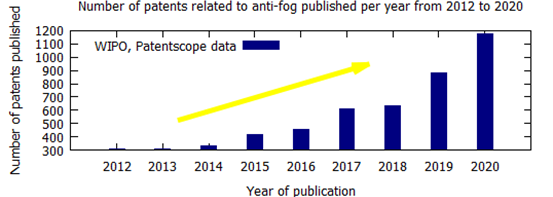The fog problem
The fog formation can be explained by physicists as the condensation that takes place due to the temperature difference between the environment and the surface. You can imagine an analogous situation when clouds that carry water vapour enter a cold area and while they lose some thermal energy, it starts to rain. The formation of little water droplets can be quite annoying if it spoils the transparency of certain surfaces. Who hasn’t seen a person wearing eyeglasses and the sanitary mask complaining about that?
This phenomenon can take place in endless situations in our life. Some of them are just irritating such as taking a picture on a rainy day with poor resolution or primping in front of the bathroom mirror without even seeing yourself. However, in other cases it’s clear that danger can outstand if we are not dealing with this problem, for example, driving the car during winter or working with a drill wearing safety glasses.

Some awkward solutions
Some commonly applied solutions to fog formation are based on heating in any way the surface where moisture can be placed. While we are driving, we switch on the hot air to warm up the glass; it’s also typical to rub frenetically your glasses with your clothes. The bravest ones even decide to add saliva to the fogged surface. Don’t be fooled, those tricks maybe will solve the problem for a while but they will imply the risk of damaging the material by heating or rubbing it. Please… let’s take a look for better solutions.
It is popularly known that substances as soap, wax, or toothpaste contribute to avoiding fog formation; it’s also a time-limited solution that might harm your health if it’s applied to surfaces as eyeglasses. These home-made wisecracks can help us in exceptional situations but it seems clear that they can’t be the final solutions to this common problem.
Good news, anti-fog coatings
Fortunately, technology is constantly evolving and, during the last decades, there has been a great evolution in the field of anti-fog products. A proper way to understand the importance of a topic in the scientific and technological market is to take a look at the patents related to it, one can find more than 4500 patents linked to anti-fogging procedures released during the last 40 years. It’s also remarkable the constant rise of patents publicised annually during the last 10 years, being the United States and China the world’s headers (WIPO, World Intellectual Property Organization; PATENSTCOPE database).

There is a special interest in new solutions capable of obtaining long-term anti-fog solutions based on applying thin films with specific properties that difficult fog formation. By modifying the interaction between water droplets and the material, hydrophilic and hydrophobic materials can be obtained. Those properties, conveniently used, can reproduce the desired anti-fog effect. Taking into consideration the fact that these coatings offer long-term solutions, they are, for far, the most attractive way to treat fogging problems nowadays. PhotonExport provides innovative anti-fog solutions enabled to develop glass coatings using sophisticated high vacuum techniques.
It’s usual to find anti-fog coatings in car windows, eyeglasses, diving goggles, integral helmets, high calibrated mirrors, virtual reality devices, photographic camera lenses… In general, a great bunch of varied applications, from quotidian to technical, from luxurious to vital.
